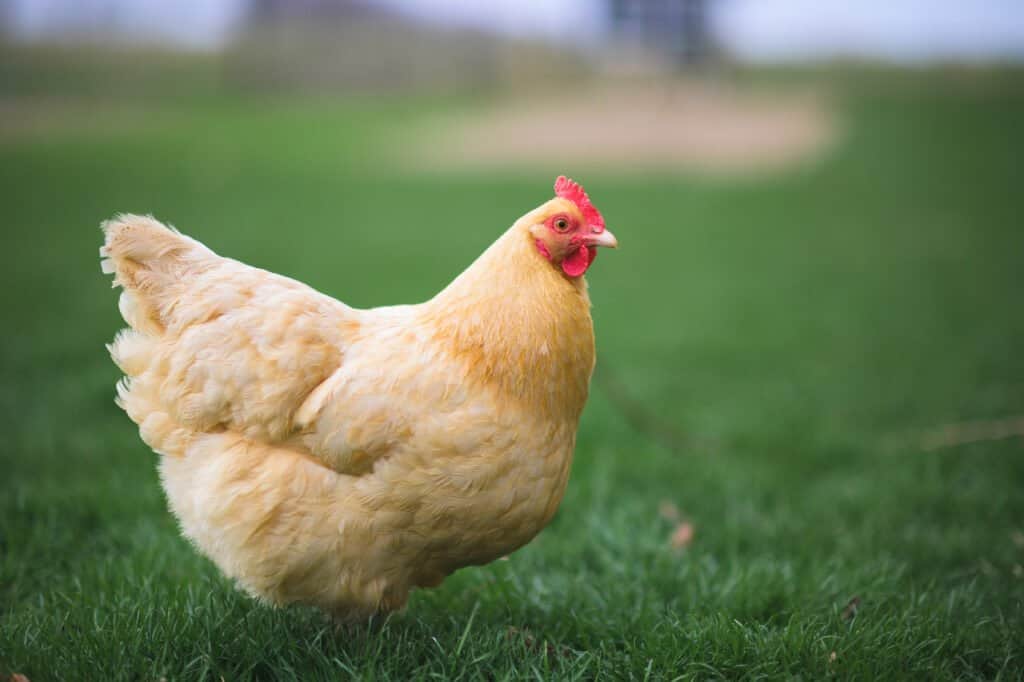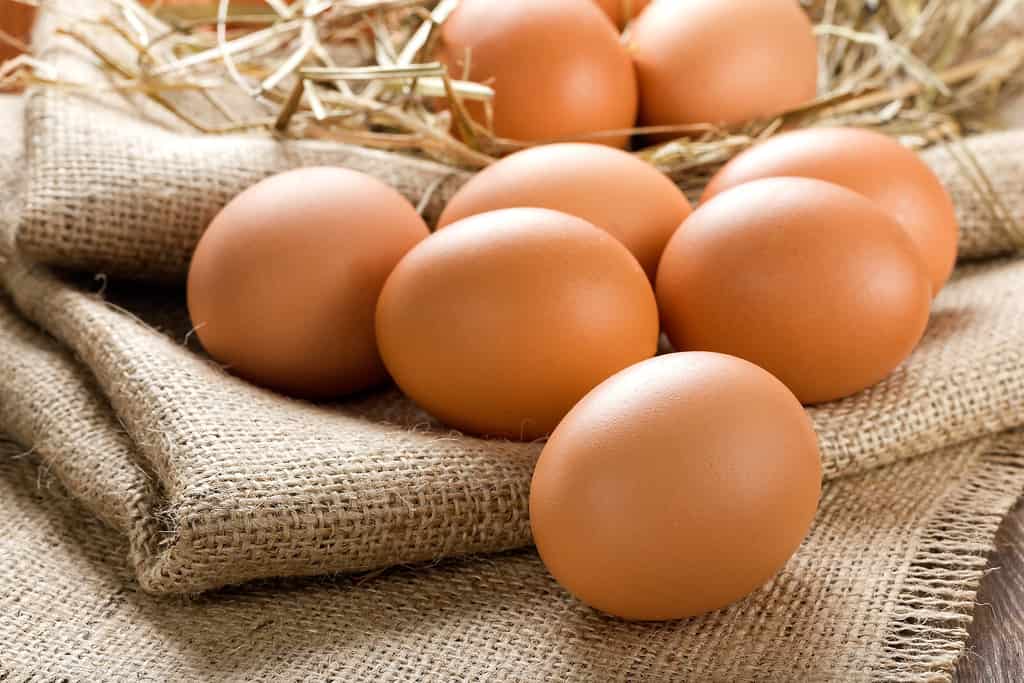Are you ready to start your very first chicken flock? Or is it time to add a new breed to your coop? One popular breed to consider is the Orpington. These amazing chickens have been very popular among families and homesteaders since they arrived on the scene over 150 years ago! But what are they, and why should you consider bringing some chicks home? Here, we will cover everything you’ve ever wanted to know about Orpington chickens so you can make a solid decision.
| Breed | Orpington |
| Lifespan | 8 to 9 years |
| Time to Maturity | 22 to 26 weeks |
| Size | Hens weigh 6 to 8 pounds Roosters weigh 8 to 10 pounds |
| Tempermant | Docile and friendly |
| Number of Eggs | 150 to 250 annually |
| Egg Size | Medium |
| Egg Color | Light Brown |
Where Did Orpington Chickens Come From?
Orpington chickens are an older breed that has been around since the mid-1800s. William Cook originally bred them in England in 1866. While the exact heritage of this breed is unknown, most believe it is a cross between Plymouth Rocks, Langshans, and Minorcas. Cook’s goal was to produce a first-rate, dual-purpose bird. And he certainly succeeded!
The American Poultry Association recognized Orpington chickens early in the 20th century. The buff was the first to make the cut in 1902. It was followed by black and white in 1905 and blue in 1923.

Orpington chickens were first developed in England. The goal was to breed a high-quality dual-purpose bird selectively.
©Tyler T. Photography/Shutterstock.com
What Is the Orpington Chicken Best Known For?
Since this breed was developed to be dual-purpose, it is really known for that. The large size of hens and roosters ensures there is ample meat. They reach peak roasting size by five months old.
Additionally, Orpington chickens are reliable egg layers. You can expect a consistent supply of medium-sized brown eggs.
Aside from their utilitarian purpose, this breed is also known for its gentle, docile, and friendly nature. Orpingtons make fantastic additions to families and often get recommended to those with small children because they are so easygoing.
Orpington Chicken Characteristics
Because of their size, Orpingtons are considered a medium to large chicken. Roosters weigh up to ten pounds at maturity, and hens aren’t far behind at eight pounds. They have a thick coat of fluffy, soft feathers that help protect them against the cold. This feathering even extends to its thighs.
Their backs are curved, which lends to a slightly heart-shaped appearance. Orpingtons have white earlobes, red wattles, and a rose or single comb.
This breed is extremely cold-hardy. The birds can handle temperature swings, particularly on the colder side.
What Colors Are Orpington Chickens?
One of the fun parts about raising chickens is that you can find breeds in nearly endless color combinations. And that holds true for Orpington chickens as well. The only colors recognized by the American Poultry Association are black, buff, white, and blue.
However, that doesn’t mean these are the only colors available! Several non-standardized colors are floating around on the market. They include gold laced, partridge, jubilee, and more.
Your hens and roosters will have similar coloring, regardless of which color you select. So it will be difficult to tell them apart at a young age. Typically, you will begin noticing differences as they mature, starting around eight weeks.

There are only four recognized Orpington chicken colors. But there are many unstandardized colors available if you can find them!
©Aiselin82/iStock via Getty Images
Orpington Chicken Temperament
This breed is exceptionally friendly and well-loved by its owners. It fancies itself a lap bird and has no problem snuggling with you while you relax. Orpington chickens are docile and fantastic around small children. They are calm and make little noise, making them suitable for suburban life. This bird is definitely beginner-friendly!
The only issue is that due to their gentle disposition, more dominant breeds tend to bully them. So, if you keep multiple breeds together in your flock, keep an eye on inter-chicken dynamics.
Know that the hens lean toward the broody side. This characteristic could be positive or negative, depending on your goals. If you want to raise a large flock, the motherly nature of Orpington hens will help tremendously. But if you are primarily hoping for tons of eggs, make sure to keep a watchful eye on the coop.
Orpington chickens are closer to homebodies than intrepid wanderers. They have no problem foraging…if they have to. But most of the time, you will find your flock hanging out in the coop or the run, waiting to get fed.
What Color Eggs Do Orpington Chickens Lay?
Orpington chickens won’t provide you with some of the fun, highly sought-after egg colors. They consistently lay brown eggs, although the shade may vary from light to dark.

Expect an abundant supply of medium to large brown eggs from your Orpington chicken hens.
©Sea Wave/Shutterstock.com
How Many Eggs Do Orpington Chickens Lay?
This dual-purpose bird is a consistent egg layer. Hens will lay approximately 150 to 250 eggs every year. These are medium to large. You can expect your hens to start laying eggs around 22 weeks old.
Do Orpington Chickens Have Health Issues?
Overall, Orpington chickens are healthy birds, so you have few problems to worry about. However, there are a few things to keep in mind to ensure your flock remains healthy.
Since they are larger birds, their perch must sit lower to the ground. Orpingtons like to hop off their perch. So, if it is too high up, they can injure themselves upon landing.
This breed has a thick coat of feathers, a blessing during colder months. Unfortunately, that same thick coat remains during the summer. Make sure to offer plenty of shaded areas during the hottest months so your birds don’t overheat. It is also important to keep those feathers as clean and dry as possible, particularly in the evening or during winter.
Like all chickens, Orpingtons are susceptible to mites and lice. Take time to comb their feathers to catch any potential issue before it becomes a problem.
How Much Space Do Orpington Chickens Need?
Orpingtons will need slightly more space than the standard allotment (four square feet per bird). So, if your coop was designed for slightly smaller birds or flocks, you may need to expand. Plan on a minimum of four and a half square feet per bird. However, you’ll need even more space if other breeds currently live in the coop. For mixed flocks, plan on up to six square feet per bird.
Additionally, Orpington chickens need a sizable perch. Plan on approximately ten inches per bird. And as we mentioned previously, these perches should sit lower to the ground to prevent injury.

The size of your chicken coop will depend on many factors, not the least of which is how many chickens are in your flock.
©Cynthia Farmer/Shutterstock.com
How Much Do Orpington Chickens Cost?
The price point for Orpington chicks will vary slightly depending on what region you live in. However, generally speaking, the chicks run between $2.50 and $4.50 each.
Of course, this price fluctuates depending on several factors. One of those is the quantity of chicks you plan to purchase. Most hatcheries will offer tiered discounts based on how many Orpingtons you buy. So, plan on paying a premium if you only want to start off with a small number. And the opposite is true if you purchase them in quantity. Doing so will result in significant savings per bird.
On top of that, hatcheries will typically differentiate between male, female, and unsexed. The latter is often cheaper since what you get is truly a tossup.
The photo featured at the top of this post is © Victoria Moloman/iStock via Getty Images
Thank you for reading! Have some feedback for us? Contact the AZ Animals editorial team.






